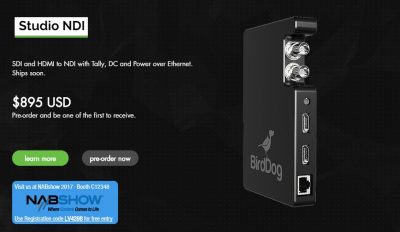Matrox Monarch Edge: NAB Product of the Year!
By Adam Noyes
Product of the Year in Remote Production & Best of Show Winner
Matrox Monarch EDGE – Product of the Year in Remote Production & Best of Show Winner

Product of the Year in Remote Production & Best of Show Winner
Matrox Monarch EDGE – Product of the Year in Remote Production & Best of Show Winner

From bird-dog.tv Emporia High School, located in rural Kansas is home to The Mighty Spartans athletic teams. Live Streaming the games allows Matthew Fowler, Electronic Media Specialist, to teach all […]

*|MC:SUBJECT|* *|MC_PREVIEW_TEXT|* Promo Rules Program starts January 3rd and ends January 30th, all Birddog registered partners can benefit from the program as long as they apply. To apply, Reseller must […]
 The lecture capture market has existed for over a decade and is growing rapidly. As more higher education and K-12 classrooms make remote student learning accessible, it creates a new and growing revenue for the schools.
The lecture capture market has existed for over a decade and is growing rapidly. As more higher education and K-12 classrooms make remote student learning accessible, it creates a new and growing revenue for the schools.


One of the most attention getting features of the new Monarch LCS is the ability for the layout to be viewer-defined. When paired with compatible third-party media players the viewer gets the option to select the layout they want to view.

 BirdDog TV (www.bird-dog.tv) announced it is formally launching BirdDog Studio NDI at NAB 2017 in Las Vegas, NV this week. BirdDog Studio NDI is the industry’s first HDMI/SDI to NDI encoder, enabling virtually any camera to instantly connect to IP workflows for live productions.
BirdDog TV (www.bird-dog.tv) announced it is formally launching BirdDog Studio NDI at NAB 2017 in Las Vegas, NV this week. BirdDog Studio NDI is the industry’s first HDMI/SDI to NDI encoder, enabling virtually any camera to instantly connect to IP workflows for live productions.

If you’re using Pearl-2 or AV.io 4K with your Panasonic GH4 camera, chances are you’re trying to capture and encode 4K video.
According to Panasonic’s user guide, the Panasonic GH4 Lumix camera only supports 4K video in Creative Video Mode and when one of it’s 4K video quality settings is configured.
Use these quick instructions to configure your GH4 for 4K UHD or 4K DCI (Panasonic calls this C4K or Cinema 4K) and get ready to capture in 4K!

Editor of TVTechnology, Bob Kovacs writes from his own experiences and gives insight to how cellular bonding has changed the broadcast industry.
Ten years ago, I worked for Sprint Nextel as an engineer on the 2 GHz relocation project (aka the “BAS Relocation”). At that time, broadcasters didn’t have much choice to get signals from remote feeds back to the studio: It was either ENG microwave or satellite trucks.